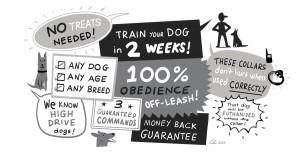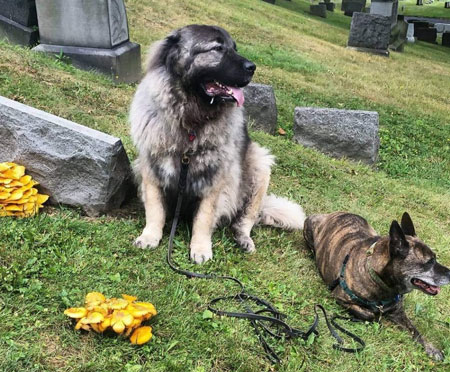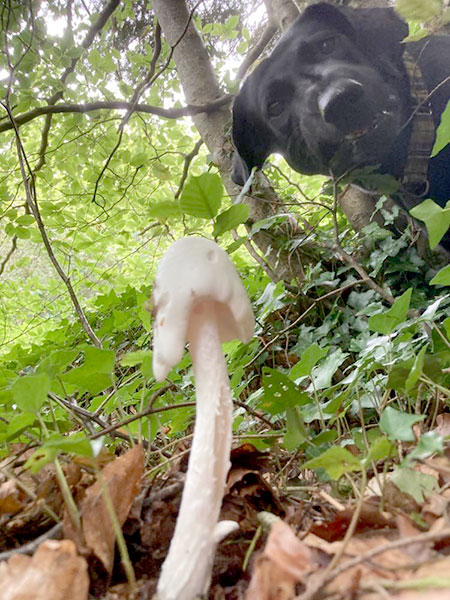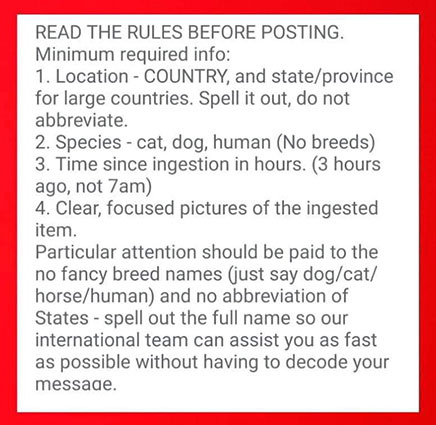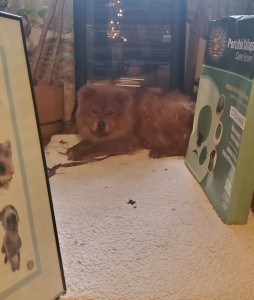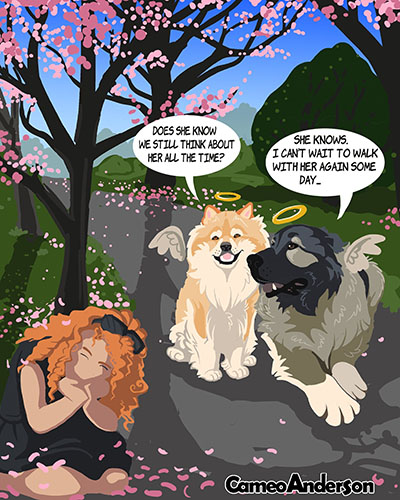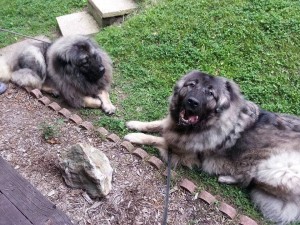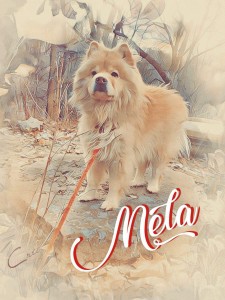
Mela — September 2021
November 22, 2014 to February 14, 2022
I used to tell myself most days when I was stressing badly because of work or traveling between clients on busy city highways, that as long as my dogs are healthy and alive, it’s a good day. Then my world crashed all around me when Mela was suddenly taken from our lives. Of course, it’s still considered a good day while Kenzo is alive and healthy. But he is nearing 10 years of age and at 165#, that is not young and he has health issues. So my trust in the universe is gone at the moment and I am not sure that it will ever return. I am no longer the same person and that makes me sad. As most who are reading this know, I lost my beautiful Chow Chow Mela on Valentine’s Day 2022. That is a holiday that I will never be able to celebrate again. It only means sadness and loss now. I have not been able to flip the date on my daily calendar from that day. It sits unchanging as I feel like a part of my life stopped that day.
Mela is everywhere and she is nowhere. I have put almost nothing away. I sometimes think that I am waiting for an alternate reality to be revealed and for my beloved and opinionated dog to be back in my life, without any memory of her not being here for a bit, on anyone’s part. Her leash sits on it’s hook just below Kenzo’s. Every day I pull his leash off and look at her pink one underneath. I cannot bring myself to move it. Same with her pink Freedom harness. It still lives on the same stool where Kenzo’s lives when not in use. I cannot even think about washing it without breaking down. Her Trixie Mad Scientist toy still sits in the living room, in front of the end table, half full with the only kibble that my dogs ever ate, and waiting for her to come and swat at it. I did move her bed from the kitchen floor to a folded-up spot next to the couch. That is all that I am comfortable doing just yet and that was only to not step on it multiple times a day. Kenzo stopped and sniffed it every single time he passed it for several days after her passing. Now he just walks by as I expect her scent has faded. That makes me sad.

Her toys, mostly double-digit numbers of stuffed balls of varying large sizes, are still all over the bedroom and some in the living room.
I have cuddled with one in particular downstairs, a huge stuffed hamburger that is not a dog toy but rather I think for kids. I bought it for a Christmas gift from a thrift store. I had it sort of hidden (or so I thought) on a kitchen chair that is only used for storage, for days. One day, several days prior to Christmas, she walked by that chair and noticed it. She subtly slipped it off of the chair while I stood behind her at the counter and watched with a smile on my face. She started walking into the living room with it. I followed her, to see what she would do. She stopped in the hallway with it stuffed into her small perfect face, turned her head towards m and batted her eyes and gave a little wag of her curled tail. I burst into laughter and told her “go ahead, it’s yours anyway”. She ran into the living room and swung it around a bit. Stuffed ball like toys and other stuffed toys that were large and somewhat ball like were how she self-soothed. I don’t know how long I will go without picking them up. Kenzo doesn’t play with them. But they are a constant and necessary reminder of how much her life meant to us both. Every night before we settled into the living room, as I was getting the bedroom ready for bed later, she would come up and wait for my prep to be done and we would play “tug” or play “fight” with one of her balls. I always waited for her to choose which one to play with that day and how the play would go. Some nights she wanted to play tug with it and other nights, she wanted to shake it back and forth while I watched and still other nights, she wanted me to play slap her with one. Sometimes I was too tired to be too into it but most nights, I happily participated and sometimes even initiated it when she hesitated. Other times, I faked the energy to participate, because of how special that I knew this time was to both her and I. But with an incredible amount of regret and anger at myself, I remember that sometimes I was simply too emotionally spent to even do it for a moment and I just grabbed one of her balls and brought it downstairs, hoping that she would follow. Now I cannot even describe the sorrow that remembering those times, no matter how few they were, brings me. I want to turn back time and play every single time she even thought about it. Occasionally, I had to persuade her to play during that time slot but more often it was her raring to go. I miss that so much.
Now I go upstairs with my eyes down on the floor, trying not to look at where she isn’t. Being upstairs without Kenzo is the hardest. Kenzo only comes upstairs at bedtime or if he’s terrified of thunder or fireworks and I usually mitigate those issues and prevent excess stair climbing as it’s hard on his knees. Upstairs was also where she was when I was gone, baby gated with her snuffle mat and free roam of the two bedrooms and her own relaxing sounds on the TV, that matched what was being played downstairs. No one greets me upstairs with whining for me to get there faster and little purple tonged kisses when I come home. The upstairs is so empty that it’s harder to exist up there now. She isn’t there to hop on the bed after it’s made to wait for me to get fully dressed and ready for walkies. She simply isn’t there, period.
In the summertime, she would put her adorable little paws onto the air conditioner and lean onto the window pane to bark fiercely, taking care that everyone knew that the warrior princess was at watch and no intruders would be tolerated, thank you very much. Much of the time, I found this habit was incredibly annoying because she trashed my blinds before I was smart enough to tie them higher but every single time that I came home and she didn’t bark when she heard my car pull in, I held my breath and worried that something was wrong with her. I could only let it out when I heard her waking with a bark, after I beep locked my car. Perhaps even then I suspected that she was only here with us for less time that I would have liked. Her protecting the castle ferociously was her hallmark. I would trade that any day for the silence that the upstairs now holds.
The only thing that I actually have put away so far were her meds (into the “dog cupboard” hidden) and her ceramic bowl. I could not stand not reaching for it for every meal. So now it is washed and inside a cabinet. Every moment of every day has a memory of where she should be and she isn’t there. Evenings spent with her and Kenzo relaxing in the living room (or sometimes in the bedroom when my day ran later than we would have all liked) were my favorites times of the day. Evenings are my “no electronics, it’s family time”, so I have very few pictures of these treasured times. Now I wish I had more. They are in my mind, but what if my mind forgets some of the details? I cannot bear that to happen. Every evening after dinner was (and still is for Kenzo) ice cream/chew thing time. Then they napped near me, with Mela usually wanting pets first. I loved those pets, her back leaning into my legs if I was on the loveseat or into my chest if I was on the floor. Or maybe she wanted her chest scratched. Either way, there were always pets first and then naps until we headed to bed. Kenzo always on the big bed on the floor in front of me and Mela on my left. Sometimes after pets, she laid on the huge bed behind Kenzo.

Mela, on her pup protector throw.
Most times, on the carpeted floor next to the bed. I always tried to persuade her to get on the bed. She always seemed a tiny bit worried about encroaching on his space but that would be the only time she was worried about such. She had no qualms about expressing her opinion to him usually and he just turned his head away like the peace lover that he is. Other times, she would briefly lay on the couch looking exquisite and timeless on her pup protector throw. I loved when she did that, but it was never for long. Most of the time, she would go to the side of the loveseat, to my right and lay in front of the door. I think that wanting to see anything coming at her was a remnant of her (hopefully brief) stray past.
Her past is likely what made her a challenging dog to live with. I have never liked easy dogs so she was a breath of fresh air, despite her idiosyncrasies. Here is how she came into our lives. There were many challenges to overcome. She had something that I call “frustration intolerance”. I am not sure what other trainers call this behavior but it involves not knowing how to self-sooth when over-stimulated so redirecting contained frustration or over-stimulation onto a housemate (usually the least likely to fight back) or a human family member (again, same temperament) was how she let the frustration out. At first, when over-stimulated, she would bite Kenzo in the side of his face. Now Kenzo is 165# and Mela was at most, 42# and his face is furry so all she got was a mouthful of fur, as he usually turned his head. He is conflict avoidance in action most of the time. But occasionally, he got upset and fought back. It was exactly one of those times, with all of us rolling around in a creek with me separating them, in rural northern Pennsylvania on 65# secluded acres while on vacation that decided me to get her on behavior medication when we returned. I had to experiment with titrating (with my vet’s blessing, of course) very carefully as she was more sensitive to the medication than most but we found her happy dose eventually. Since she was too over-stimulated to take food rewards outside, I had to simply verbally capture her not reacting. I started with capturing her looking at things that might excite her at a distance and reinforcing that. She first switched to biting her leash instead of Kenzo and I reinforced that. I also reinforced all sniffing for displacement and she eventually was able to do that instead of biting her leash. At some point, she learned to shake off on cue as well as to sniff on cue. This did not happen overnight but it was all worthwhile. She stretched my training and behavior modification skills quite a bit and I am grateful for everything that she taught me and every moment we had together, even the difficult ones. Her trust did not come easily and handling was still an issue with many husbandry issues. It was a back and forth momentum with some progress and some backslides. Once it took her an hour for her to allow me to muzzle her to be seen at the vet’s office. But with a lot of work directed towards the dental procedure that she never got to have, the most recent vet visit only a few months prior (with good bloodwork!) only required a minute to have her trust me to get the muzzle on. I wish I had more time to spend building more trust. I will always be grateful for what trust she did bestow upon me.
The day that she was taken from us was a Monday like any other. But I was already agitated about something I cannot even remember now. One of her behaviors that seemed to creep back in the previous weeks was her running up to bark in Kenzo’s face when he got into my SUV after she did. I “solved” that problem previously by treat tossing to her as he got in and he got treats as well once inside. She usually then jumped in her regular front seat spot and off we went to the park or cemetery. But only very recently, she had been eating the treats and then running back to snark very rudely at him as soon as he got in afterwards, after I had closed the doors. I know that behavior modification progress is always back and forth but she had been great for so long, it was surprising. But that doesn’t stop me from feeling like a mama bear about it. That day she was snarkier and I was frustrated. He was very sensitive to that sort of thing and she had been so good for so long and his arthritis was making him be more vulnerable sometimes. Now I feel that perhaps her backslides on some behaviors were perhaps a symptom of whatever took her from us later that day. I wish that it occurred to me then but I am not sure that calling my vet and telling her that Mela was being extra rude that day would have resulted in a productive visit. Mela was known to be Mela. I try and console myself with this but it’s still a process.
We went to the park and had a nice walk, but she was pulling much harder than usual. Now Mela could probably pull a full-size pickup on a good day, but it usually didn’t last the entire walk. So again, my irritation at her, not outwardly obvious but there and enough to instill guilt for the balance of my life. Getting back in the car to leave that day, I realized that Kenzo had a small poop accident (first time ever in the car) so I cleaned up as best as I could and folded the blankets down so that the mess wouldn’t spread. But of course, this didn’t help my mood. Leaving the park, we encountered a stoppage at the part of the park loop where some reconstruction was taking place. Several dogs walked by, and she launched herself in the back of the SUV and barked at them. All in all, pretty normal for her. And not normally something that I would dwell on as she would simply come back up to her seat pretty quickly most times. She sometimes remained in the front seat to whine and bark mildly and sometimes she went to the back. She always got food rewarded for maintaining her place. But this day, she stayed back there and she was taking it out on Kenzo instead of just barking at the dogs outside. Again, he just turns his head, but he doesn’t deserve that. I yelled at her. I am incredibly sad about that now. I console myself with the fact that they have heard me yell a lot over the years (we live in the inner city) and it’s nothing to them and usually isn’t directed at them anyway, but I still wish it hadn’t happened. Finally, we got to a point where I could attach her harness to her tether in the front seat. It was all good again. We went to the grocery store and went home. I cleaned Kenzo and the car up and loaded up the laundry. I did meal prep (they eat home cooked) and gave them lunch. They settled down for a nap on the kitchen floor next to me. A normal Monday afternoon as that is my admin day. But my mind was still somewhat resentful towards her extra behavior earlier, though there was no outward signs of that she would have detected. Kenzo on his bed and Mela between her bed and a rug that she sometimes used as a bed instead of her actual kitchen bed just a few inches away. Three hours went by. I was just about to send the last summary and take them for their second but individual walks down the back alley. They loved that short but solo walk. Then this happened. The short version is that she let out a terrible sounding cry. I rushed to her, thinking that I would be consoling her out of a bad dream but as I cradled her in my arms, thinking that I was surprised she was allowing that, she arched her neck and let out a breath and that was her last. My screaming could have been heard for a mile. I called my vet crying hysterically and rushed her there but I knew that she was gone. Our lives are forever changed now. Instead of settling happily in the living room with my 2 perfect Valentine’s, after dinner celebrating with some doggy ice cream and bully bites, I was consoling Kenzo and crying so much that I vomited.
Mela was scheduled to get a dental extraction (and cleaning) just two days later on February 16th. I was terrified of this and had asked to push it out a bit but was told that pushing it out would mean June and all I could think of was what if her tooth was hurting her and removing it would help her feel more comfortable overall? So I stuck to the originally scheduled date and grew more and more worried. Mela was scared at the vet’s office and for her, scared meant that she lashed out angrily. She has always had to be muzzled but prior to having a vulva rash/infection several years ago, could be restrained by me and examined with even getting bloodwork being undramatic, as long as I was holding her. But that discomfort of that rash/infection changed everything and she would fight even being held by me, making it dangerous for everyone present, even with her muzzled. So, while I had taught her some solid husbandry things, outside of a quick vaccination after muzzling, she always had to sedated for thorough exams after the vulva incident. I could hardly bear the thought of her there at the vet’s office without me, even though I would be present initially when she was sedated. I felt like I would be betraying her. All I can think about now is did the universe take my beautiful little girl ahead of this dental procedure because although traumatic for me to lose her in such a manner, it would be less traumatic than losing her without me present, during or after a procedure that I was already feeling so frightened of? And if so, what if I had simply pushed out that dental until June? Would I have gotten the most magical gift of having my little baby girl in my life a bit longer? Only the universe can answer these questions. But my pleas for answers are falling on deaf ears. The universe doesn’t provide that kind of feedback unfortunately. I don’t trust the universe anymore and I don’t know how to regain that trust. If you have suggestions, I am all ears, but don’t make those suggestions about any sort of religious options please.
While the Monday that we lost her was like any other Monday, aside from what happened and the strangeness that preceded it (a harbinger of what was to come?), the 3 days prior to losing her were a huge gift from the universe, again perhaps knowing what was to come? The Lemonade Conference, a virtual dog behavior conference was the previous Friday, Saturday, and Sunday so I was home with my two beautiful dogs for three glorious days when I would normally have been working. That meant that even though I was watching presentations, they were next to me in the kitchen relaxing and there were longer walks at more relaxed venues such as the park, than there usually were on those typically my busiest of workdays. There was no coming home late and tired on my part and there was extra energy in our afternoon “alley walks”. When my presentations were done for the day, my workday was as well since I could answer email inquiries during presentations, so we retired to the living room earlier than on workdays. I will forever be grateful for those days. It makes the Monday that followed a tiny bit easier to swallow, knowing that I got those special extra minutes with her when it would not normally be the case.
I realize that there really isn’t anything instructive for other on my part by writing these words but I have to get them out, if only to show the world how very important Mela’s life was and to purge some of the anguish that is inside of me. If you are still reading, you are very kind and I thank you. I have never before lost a dog so suddenly and completely unexpectedly like this. It feels drastically different than losing one to old age/illness, when one has time to prepare a bit. It feels like my relationship with her wasn’t allowed to be completed and I hope that one day, I will get to tell her how very much I love and miss her every single day. I hope that she is hanging out here in another form that we cannot truly see and she knows this already. I also hope that we all get to be with our lost loves again in another realm and see and touch them again for real. Until then, I will talk to her (and my other lost loves) daily. And I will leave you with this. Never ever take for granted “later”. I thought that there would be a later that day for us to reconnect. Later was stolen from me. Cherish the now. You never know whether you will have to live with the pain of being frustrated with someone you love. I know that’s just being human but it hurts incredibly badly all the same. So cherish the now please. For Mela.
I have decided to add some grieving resources that friends were so kind to provide. We all grieve differently. Maybe these will help someone else:
Grisha Stewart’s musings on Peanut’s loss
Grisha Stewart on mourning
Pet Loss and Bereavement Group
Rainbow Bridge Grief Loss and Grief Support




